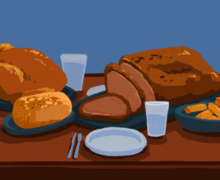Mechanics of the mind: Experts explain why sex offenders are caught in cycle of abuse
It’s a title you can never escape from. A title so heinous it becomes your identity.
Sex offender.
‘That’s the thing about sex abuse, it’s probably — beyond murder — one of the worst things we can think that could ever happen,’ said Allison Young, director of sexual abuse services at Elmcrest Children’s Center. ‘Sex with a child is awful, it’s disgusting, it’s despicable. There’s no going back from that. I could never look at someone and say, ‘I forgive you for that.”
Young said sex is a controversial subject on its own, but the topic of sexual abuse is strictly taboo. People don’t discuss it because no one wants to believe that such acts occur.
The issue of child sexual abuse gained national media attention after the Jerry Sandusky scandal at Pennsylvania State University and Bernie Fine case at Syracuse University. After the second scandal was brought to light and a slew of victims stepped forward, the media began to portray the spread of sexual abuse as a new epidemic running rampant throughout society.
But sexual abuse, Young said, is much more prevalent than people are aware of or want to admit.
About one in four females and one in six males are sexually abused by their 18th birthday, said Young, who treats adult sex offenders in private practice, as well as child victims and children who act out sexually, at Elmcrest.
In her work with both adult offenders and children who act out sexually, Young looks to explain exactly why adult sex offenders display the type of behavior they do.
‘In order for us to help understand how to prevent this, we have to understand where it comes from and what we’re targeting,’ she said.
Common denominator
All offenders have a past. Oftentimes, it’s a significantly traumatic one, Young said.
Though not all victims or survivors of sexual abuse become offenders themselves, almost all adult offenders were abused in some capacity during their youth. This alone leads most offenders to remain at the emotional age at which they were first traumatized, she said.
This emotional blocking can turn into isolation and an eventual lack in socialization altogether. Oftentimes, the offender won’t be able to fit in with society or a group of their peers — an issue that can likely be traced back to adolescence, Young said. Offenders begin to relate to children on an emotional level, as they are unable to make connections with people their own age.
For former victims-turned-offenders, social and sexual frustration can become powerful motivators for committing acts of sexual abuse. If they are able to overcome their conscience and begin justifying behavior they know is wrong, they may intentionally place themselves in a position where they will be closer to children.
Some offenders use that proximity to take advantage of the children, though not always sexually, Young said.
Young and other experts said this explains why sex offenders will often turn out to be people who have a close relationship with adolescents.
Catherine Diana, the owner and director of NuStep Professional Counseling Services, has more than 30 years’ experience working with adult sex offenders and adolescents that have experienced abuse and react in the same manner to other kids shortly afterward.
Children who display this type of behavior are never referred to as offenders, as they are minors and are usually just reacting to their own victimization, Diana said.
Diana said that while adult offenders were usually abused themselves, they also tend to share a history of neglect or unclear boundaries set in the home.
‘The very beginning stages of an infant’s life and how they’re nurtured and cared for is absolutely critical,’ she said. ‘If there are clear boundaries in the home and that child has been nurtured in a healthy, supportive environment, I think the likelihood of there being sexually offending behavior is very low.’
Hard-wired
There are currently 971 sex offenders in Syracuse, according to the National Sex Offender Registry (familywatchdog.us). Though society may think of all sex offenders as pedophiles, this is not the case, Young said. There are multiple types of offenders, ranging from rapists to pedophiles to exposers.
But although Young said all of her patients need treatment, pedophiles can be the scariest to deal with because they don’t want to change. Out of the eight male offenders Young treats at the private practice, two are pedophiles, she said.
Pedophiles are people who are sexually attracted to children 10 years old and younger, Young said. These offenders, although more uncommon, are at a higher risk to commit an offense, she said.
Most of Young’s other patients are considered regressed offenders, meaning they want to have relationships with people their own age but may have taken advantage of an opportunity with a teenager with whom they were close.
During the past few decades, research has been done on the brain of sex offenders. James Cantor, a Canadian psychologist who works at the Centre for Addiction and Mental Health in Toronto, has published multiple journals in an attempt to better understand what makes people sexually abuse children.
When comparing brain scans of pedophiles, Cantor found that the offenders have less white matter connecting areas of their brain that make up the ‘sex network,’ which includes the visual and motor centers, according to his 2007 research. Cantor theorizes that the lack of white matter, which acts as wiring for the brain, results in a sexual response to children instead of a nurturing one.
Young and Diana both agree that while this research may make substantial points, it is new and not foolproof. Young said she does not believe her patients are born sex offenders. Rather, they become them through environmental factors.
Most adult offenders are also male. Diana said this may be due to the fact that female victims of sexual abuse tend to internalize their trauma, acting out later in life in ways that may hurt only themselves, such as cutting or prostitution. Men, on the other hand, tend to externalize their pain, often through aggression toward other people.
Protecting the innocent
Though it may not be feasible to completely stop sexual abuse, Diana and Young said if people begin to become educated on the topic it will be less likely to occur.
Diana said it worries her that adolescents are not fully aware of laws and regulations that directly affect them.
‘There are a lot of high school teenagers that don’t even know the age of consent in New York state. They don’t even realize that at the age of 17, if they’re being sexual with their 16-year-old girlfriend they could be arrested.’
It’s crucial that parents talk to their children about their bodies and encourage them to tell someone if they ever feel uncomfortable — even if the person who is making them feel that way is a family member, Young said.
‘An elbow is an elbow — we don’t make up a funny name for that. We don’t talk about your penis. Therefore, it gives kids the message early on that there’s something to be shameful of.’
Published on February 27, 2012 at 12:00 pm
Contact Liz: egsawyer@syr.edu | @3sawyer





